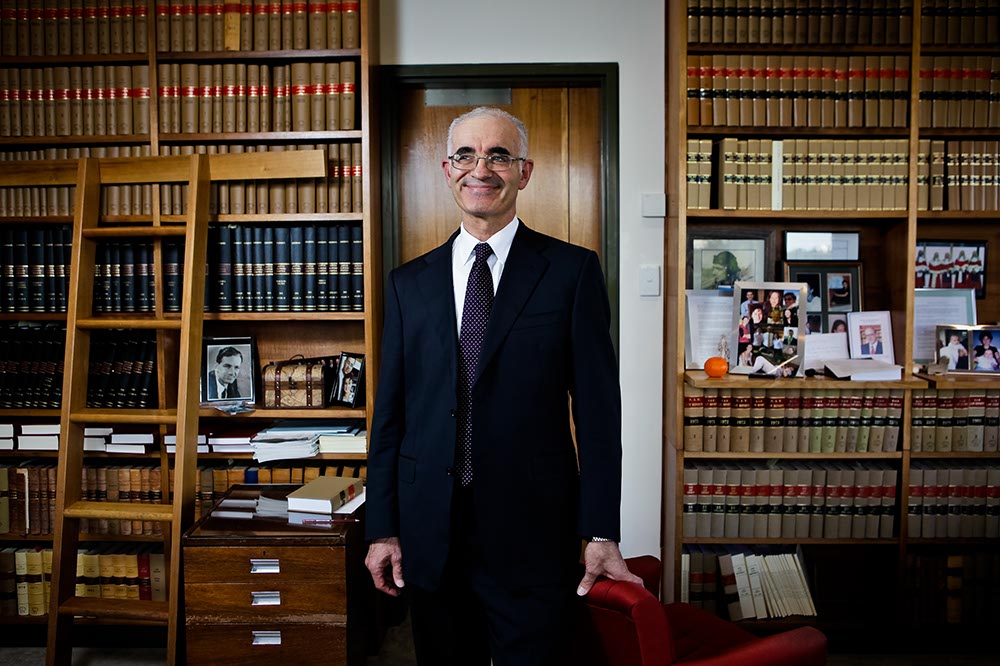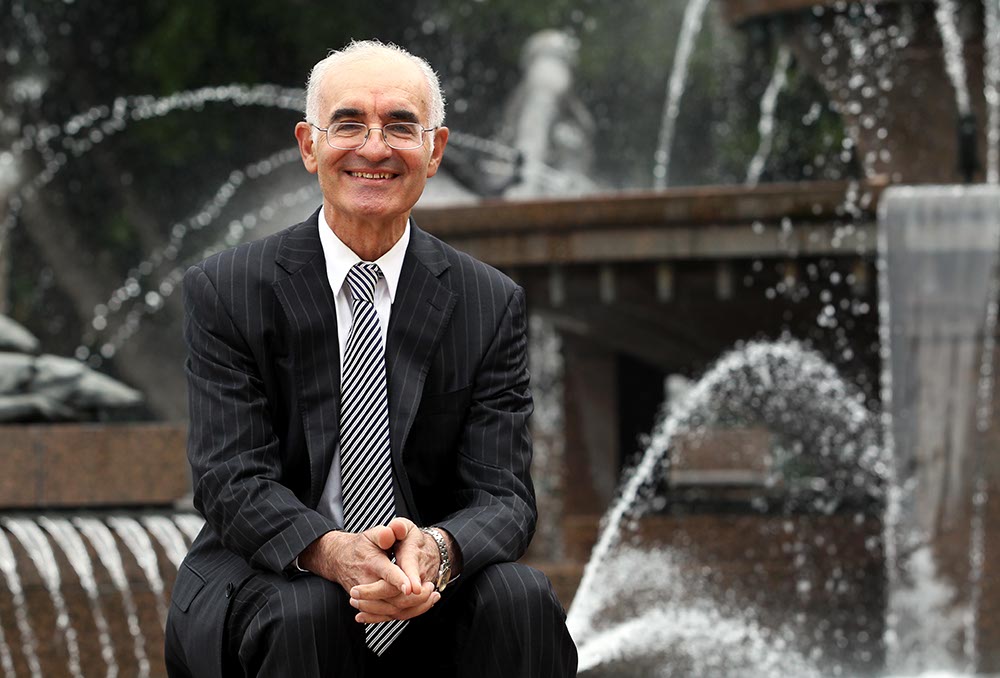Obituaries
The Honourable Clifford Roy Einstein QC
(1947 – 2020)
Barrister, Queen’s Counsel, Judge of the Supreme Court

T he Honourable Clifford Einstein QC who has died aged 72 years, was a senior judge in the Equity Division of the NSW Supreme Court between 1997 and 2012. His Honour’s experience, coupled with his extraordinary work ethic, made him an ornament of that Court
His honour was born in Johannesburg, South Africa on 28 September 1947, the eldest son of Alf and Celia. Those years were tumultuous to say the least on an international scale. The family comprised his mother and father, his younger brother Leslie (also a barrister) and his sister Sandi. Celia strived to ameliorate black townships and to advance the status of women. Alf was a political activist and co-found the anti-apartheid Progressive Party. However, as times changed, the Einsteins resolved to leave South Africa.
The family resettled in Sydney in 1963. Einstein QC completed his secondary schooling as a prefect at Vaucluse Boys High School. Einstein QC was a school prefect and a member of the debating club. Even in his youth, his Honour had the gift of the gab and loved a good verbal tussle. Einstein QC was a star orator seemingly on any topic.
In the early 1960s, opportunity abounded in Sydney and the sky was the limit for a young man like Clifford Einstein. Foremost in the early years, were his scholastic achievements. He was a fine scholar and a debating champion. His unflappable nature would take to the Bar and beyond.
On achieving a Commonwealth Scholarship, he was admitted to a combined Arts Law degree at the University of Sydney. He continued his fine academic record and on graduation was proxime accessit .
Shortly after finishing at the University of Sydney, he married Judith Reves, the daughter of a well-known Sydney architect.
His Honour took articles of clerkship with Messrs Michel & Gee, later known as Minter Simpson (later Minter Ellison). Even then, he was an ambitious and very industrious young lawyer.
Einstein QC was admitted to the Bar on 27 July 1973. His pupil master was Theo Simos (later QC, a Supreme Court Judge and now deceased). As a pupil barrister, he spent a year licensing the chambers of Michael Kirby (as his Honour then was). The following year he acquired chambers on 10 Wentworth and started to build his reputation under the watchful eye of Ken Hall, the doyen of clerks at the time. He was popular, affable and friendly – he instigated Friday afternoon '10th Floor' gatherings to promote a collegiate spirit on the Floor.
Einstein QC, as a fledgling counsel, was in the limelight. Many will recall his first encounter with 'fame' or infamy, shortly after his reading year when he appeared in the Alvin Purple case Hexagon Pty Ltd v Australian Broadcasting Commission (1975) 7 ALR 233, a spectacularly salacious case which included an ingenue actress in a film. It made a splash among barristers and in the tabloids at the time.
Einstein QC ran many well-known cases, but the most celebrated stoushes were in the Commercial Equity sphere in the 1980s and 1990s – this was his calling. He was a specialist in Equity and Trusts. He informed the jurisprudence of the area in the most direct fashion, by arguing at the forefront of liability.
His Honour’s most notable cases were those with a commercial flavour but specifically those concerning fiduciary relationships which categories remain unclosed.

Einstein QC was often led by DE (Dan) Horton QC and in famous cases: Hospital Products Limited v United States Surgical Corporation & Ors (1984) 156 CLR 41, United Dominions Corporation Limited v Brian Pty Ltd (1985) 157 CLR 1, Timber Engineering Co Pty Ltd v Anderson [1980] 2 NSWLR 488 and of course, C att v Marac Australia Limited (1986) 9 NSWLR 639 per Rogers J of the Commercial Division. There were several iterations of each of these cases and they lasted years. These cases marked the rapidly expanding field of commercial equity during that era. Einstein QC like Horton QC often quoted Lord McNaghten in Reddaway v Banham (1896) AC 199: [F]raud is infinite in variety; sometimes it is audacious and unblushing; sometimes it pays a sort of homage to virtue, and then it is modest and retiring; it would be honesty itself if only it could afford it. But fraud is fraud all the same; and it is the fraud, not the manner of it, which calls for the interposition of the court . These words were the touchstone of his practice.
His Honour was a great one for remembrance of things past. He loved to relate stories with the casual air of conversation. In 1982, as a junior counsel, he appeared in the Privy Council in Newmont Pty Ltd v Laverton Nickel NL (1983) 1 NSWLR 181. He was led by DN Nicholls QC (later Lord Nicholls of Birkenhead), a leader of the English Bar, with whom he appeared before their Lordships in that famous chamber with its double fireplaces, near 10 Downing Street. He was very proud to appear before Lord Diplock and others.
In his Judge's chambers, his Honour displayed a set of beautiful silver frames containing his most precious memories: the appearance slip in the Privy Council, the pleadings of Hospital Products – a most celebrated case, and the infamous 4 million dollar cheque in issue in Catt v Marac , produced in a world where 1 million dollars was unimaginable. Those frames memorialised the gilded age, when Einstein practised at the Bar.
Einstein QC tested the notion of equitable fraud, at the forefront of liability, throughout the 1980s. Numerous large boxes in chambers, fleets of trolleys accompanied the small armies of solicitors who briefed him. He loved technology and was an enthusiast of Word Perfect, when computers were the most cutting edge in office devices. He was the consummate Queen’s Counsel.
Ken Hall, his clerk, observed that Einstein QC took every document to court. He was meticulous. Olive Toohey had been his secretary on 10 Wentworth and then Susan Piggott became his associate on the Bench. Vic was his faithful Court Officer in the Technology Court on Level 7 of Queen’s Square.
His Honour became one of her Majesty’s counsel in 1987 a distinction which set him apart. Einstein QC had an old world courtesy, a courtly politesse which nowadays tends to shock due to its rarity. His Honour had a wide, generous smile, a chuckle and a slight tilt to his head. He loved a joke. These were his personal hallmarks.
Einstein QC practised in all jurisdictions of Australia and was also admitted in Ireland.
Einstein QC achieved his ultimate goal when he was offered judicial appointment to the Supreme Court of NSW on 6 August 1997. There he would remain for 15 years sitting in the Commercial Division of the Equity Court. It was his natural habitat.
Einstein J heard innumerable significant trials – the quintessential commercial causes at the turn of the century: Idoport Pty Limited v National Australia Bank Limited in the early 2000s. It was one of Einstein J’s longest running cases, commencing on 24 July 2000. It was as spectacular, as it was interminable. Ultimately, the defendants endured and won. His Honour’s decision on security for costs is still cited at trial and on appeal regularly two decades later.
After years, the Judge would be thrust into the limelight again. A case about Holly Valance, the rising TV starlet came before Einstein J dealing with commercial managers in the entertainment world in Biscayne Partners v Valance Corp PL & Ors in 2003 – as if there were a 'celebrity' list. The cases were about the breakdown of commercial relationships and large sums of money, brought in the equitable jurisdiction where Einstein J was pre-eminent. He was in his element when sitting in a first instance court. He was very skilled in the time-honoured practice of observing the demeanour of the witness giving viva voce evidence and deciding their veracity.
For 15 years Einstein J’s devotion to the law and his family was extraordinary. He worked incessantly and discharged the judicial burden admirably. He would arrive in chambers at 6 am to start work. He would take breakfast with colleagues before court commenced. He always took a 45 minute walk during the lunch break. He would leave for home shortly after adjourning at the end of the day. After a late afternoon nap, he joined the family for the evening meal and when help was required, he was happy to demonstrate to his children how to apply oneself to efficient study.
His wife Judith would listen to his thoughts, reflections and musings of the day. It was a Sisyphean task, day in and day out, when he heard trials of a high commercial importance. He was known for his very detailed judgments and reasons thereto leaving no stone unturned. There was triumph – he revelled in the judicial life.
The Equity Division into which he was sworn comprised their Honours PA Bergin SC (who became the Chief Judge in Equity in 2008), PW Young AO QC (Chief Judge in Equity), JMN Rolfe QC, RL Hunter QC, RI Barrett, RP Austin, GA Palmer AM QC, JC Campbell QC, JP Bryson QC, JP Hamilton QC, WV Windeyer, IV Gzell QC, Peter McClellan AM QC (who became the Chief Judge at Common Law), RC McDougall QC, W (Henric) Nicholas QC and JK McLaughlin. All have retired. That Bench had unparalleled experience, knowledge and judicial savoir-faire. Einstein J was part of that edifice of judicial memory.
All of the former judges the Hon David Ipp QC, the Hon Roger Giles QC and the Hon Peter Jacobson QC, the late Hon Kim Santow and Justices Nigel Rein and DJ Hammerschlag had known him since earlier times and were his friends. He had a magical sense of humour and he loved to be in the company of others.
Einstein QC wrote and published learned and scholarly articles. The two most notable articles were 'Evidence Act 1995: Some concepts underlining Expert Opinion Evidence Provisions' and a famous comment on judicial discretions in 'Reining in the Judges: An examination of the discretions incurred' circa 1996.
Einstein J was always keen to assist other judges in alleviating their workload, often as the Judge assisting the Commercial List Judge and the Duty Judge. He kept the wheels of justice turning in a cloistered world of whispering gentleman advocates.
His Honour had a band of tipstaves who assisted him in legal research, each of whom he chose and encouraged. Their hard work was never in vain, rather, it foretold of potential to be realised. The Judge gave them enormous encouragement as well as enjoying their company. He mentored each of them before and after their engagement. There is now one Silk to that number. Of others, in and around the Court, he noticed in them what others might not, at first blush. He was a kind and thoughtful man.
Einstein J’s meticulous method of research was taken from another master of equitable fraud, the late Dan Horton QC who placed signal importance on thorough historical investigation as to the origins of certain legal doctrines and principles from 19th century Chancery cases.
In 1995 the first of several missions were organised to travel to Bangladesh and Einstein QC championed the Sydney Bar’s campaign to deliver lectures to the legal profession in Dhaka. Judith accompanied him on these trips and assisted in the monitoring of the students and many social events. She also assisted in organising the donation of much needed blankets for the elderly in a local very poor village which they visited.
With a band of other members of the Bar – books, journals, wigs, gowns and other paraphernalia were shipped to Dhaka to assist the profession. The goodwill remains to this day.

Einstein J retired from the Court in 2012. His judicial oaths had well and truly been discharged. His potential had been realised. Life had come full circle. The ensuing years were filled initially with tennis, golf, some travels and grandchildren. It was a well-deserved reprieve from the tremendous pressure of the judicial burden.
Shortly after that time, his health deteriorated. For a time in retirement, he kept up his general visibility around Queen’s Square and Phillip Street.
Einstein J was highly regarded by all who knew him and as a learned person of honesty, integrity, good humour.
In the end, his Honour battled courageously. His career had existed on the power of speech, so for such a man, to be robbed of his greatest assets of verbal expression and dexterity was a cruel blow. His steely intellect and the love of engaging with others remained, albeit silently. All who visited him were greeted by his warm, happy smile and his piercing gaze as he listened to news from colleagues, and especially if he was told a good joke. His sense of humour remained. He was most valiant to the end.
The love of his life Judith, nursed him at home to the end so he could stay in his familiar surroundings.
Judith and their children Danielle and David survive him as do his grandchildren: Joe, Sam, Ariel, Eadie and Florence. His brother Leslie and his sister Sandi also survive him.
Kevin Tang
8 Wentworth Chambers
Peteris Ginters
(1971 – 2020)
Barrister
 P
eteris Ginters, who died aged 48 from the scourge of Motor Neurone Disease, was a bright star in the constellation
of barristers at the Sydney Industrial Law Bar for 16 years.
P
eteris Ginters, who died aged 48 from the scourge of Motor Neurone Disease, was a bright star in the constellation
of barristers at the Sydney Industrial Law Bar for 16 years.
Ginters was an advocate of the first order. As then NSW Bar Association President Arthur Moses SC said at an MND fundraising lunch to mark Ginter’s retirement from the Bar in 2017, had illness not cruelled Ginter’s career he would undoubtedly have taken silk.
Ginters came from a high-achieving family. Born and bred in Sydney's Cammeray to a migrant father from Latvia and an Australian-born mother, Ginters had two older sisters, Laura, a lecturer in performance studies at the University of Sydney, and Anna, an account director in real estate. The family has always been close.
Ginters went to North Sydney Boys High School and from there to the University of Sydney, where he took degrees in Arts and Law. It was there that he made the acquaintance of his much-loved teacher Professor Ron McCallum AO.
In 1995, when newly appointed Justice Shane Marshall of the Federal Court was looking for his first associate, he called Professor McCallum AO who recommended Ginters as his best student in industrial law. Ginters became Marshall J’s associate during 1996, and gave invaluable assistance as his Honour made the transition from a young junior counsel to the Bench.
And so it came about that Ginters was present at the commencement of the short-lived Industrial Relations Court of Australia, to which Marshall J was dual appointed – a Court that lost its jurisdiction in 1997, but only came to an end on the retirement of its last existing Justice, Justice North, in 2019.
In January of 1997, Ginters commenced working as a solicitor in the firm Clayton Utz working primarily in commercial litigation and industrial law. There Ginters was under the supervision of Joe Catanzariti, now Vice President of the Industrial Relations Commission.
In 1998, less than a year after being admitted as a solicitor, Ginters was called to the Bar having obtained first place in the Bar exams that year. His commencement coincided with that of several great friends and colleagues. He became a member of HB Higgins Chambers where he found kindred spirits and friends, including Patricia Lowson, Ingmar Taylor SC, David Chin SC, now Fair Work Commission Vice President Adam Hatcher, Adam Searle MLC, the late Jeff Shaw QC, and now retired Justices Lance Wright and Frances Backman.
His primary area of practice was employment and industrial law. He also regularly appeared in professional disciplinary matters for bodies such as the NSW Medical Board, and both in that area of law and in industrial cases appeared numerous times in the NSW Court of Appeal, building a fine appellate practice.
As his practice developed he became junior counsel of choice for many NSW government agencies and departments. It is sometimes unappreciated that public sector wage claims, in which Ginters regularly appeared, involve claims for amounts greater than all but the very largest commercial cases, not to mention significant questions of legal principle.
Feelings can run deep in such cases. In one, involving a claim for increased teacher salaries, Ginters appeared for the Department. The Teachers Federation called as a witness a school principal, Judy King, who had taught Peteris at North Sydney Boys. On the way up in the lift, Ginters said hello. He said how fondly he recalled her history classes and explained he was now a barrister and was appearing for the department. Judy King responded (completely deadpan) that she remembered he had been a talented student, and couldn’t imagine where he had gone wrong.
During the ensuing years, Ginters’ career followed the rise and fall of industrial law in Australia. He was junior in the High Court on three occasions, for the NSW Police, the State of NSW, and for a group of unions.
Ginters was sufficiently authoritative to garner judicial respect while at the same time infused with humanitarian principles and ideas for extracting them from the common law, which was no easy task before the rise and rise of Human Rights – he was there when it was all taking shape.
In 2005 Ginters left H B Higgins Chambers and joined Level 15 Wardell Chambers, where he was reacquainted with Robert Reitano, who became his closest friend at the Bar. Reitano was the first barrister that Ginters confided in following his diagnosis, and took the lead in the years after Peteris’ retirement in organising get-togethers and fund-raising events, including Peteris Ginters Day on 7 November 2019. The day marked the third anniversary of Ginter’s diagnosis. Judges, barristers, solicitors and industrial relations practitioners donated their income on that day, raising more than $100,000 for MND research. In addition, other fund-raising lunches organised by Ginters and Reitano raised more than a further $50,000.
All those who had the pleasure of working with Peteris describe him as generous when it came to sharing his deep knowledge and experience of industrial and discrimination law and the NSW industrial relations system. He was known in and around the Bar for being an interpretative oracle, capable of deciphering the riddle-like questions of the more obtuse industrial judges and commissioners.
Upon receiving the news of his diagnosis Ginters was characteristically positive, constructive and active. He and his wife Caroline went about planning what time was left. He withdrew from chambers and ceased practising almost immediately, but for a final appearance on an appeal.
All those who knew him over the 3.5 years that he lived with the terrible disease came away cheered by Peteris and Caroline’s love of life. His body may have been decaying, but his mind to the end remained sharp and his sense of humour undimmed.
He did not forgo his legal training on retirement. He was probably the only person in the country who had read the whole of the NDIS legislation, other than the parliamentary counsel who drafted it. His mastery ensured that he obtained full funding and assistance.
Ginters was ably and compassionately treated and cared for by the brilliant, vibrant and earthy Dr Dominic Rowe of Macquarie University. Ginters spoke in support of the great work of Rowe and his team at every possible moment.

Ginters is survived by his wife Caroline and their two children Mason (17 years old) and Taylor (15 years), both named after High Court Judges. Caroline was Ginters’ rock, providing unending strength and love so he could enjoy his life to the fullest right to the end.
Ginters was a brilliant, humble, gentle and amusing man of great integrity and an innate sense of what is right. He mixed easily with a great variety of people, making close friends of colleagues and clients. Members of the Industrial Bar were inspired over the years by his work and his scholarship.
There was a private family memorial, followed on Sunday 16 February 2020 with a Memorial Celebration held at the Marigold Restaurant. It was by invitation only, and the entire 5th floor of that old stronghold was filled with more than 320 attendees enjoying a wonderful Chinese banquet, including more than 60 members of the Sydney Bar. The venue was entirely appropriate, it being where Peteris and Caroline had celebrated their marriage 20 years earlier, and where Peteris had hosted many lunches for clients and friends over the years.
Michael Fullilove AM, Executive Director of the Lowy Institute, and a fellow
student at North Sydney Boys, was the Master of Ceremonies. The speakers included
Ginters’ sisters and mother who spoke movingly of their memories of Ginters as a
child and brother. His son Mason gave an incredible speech focussing on Ginters’
qualities as a father. His daughter, Taylor, presented a wonderful poem she had
written about Ginters.
They were followed by Caroline who spoke with great love
and humour of the young man she had fallen in love with, and how they had got only
closer over their 20 years of married life. Ginters would have loved it.
Another individual who suffered MND was theoretical physicist and author Stephen Hawking. He said “Try to make sense of what you see and wonder about what makes the universe exist. Be curious, and however, difficult life may seem, there is always something you can do, and succeed at. It matters that you don’t just give up.”
About 12 months after his diagnosis, when the physical disability it engenders had begun to manifest, and the death sentence that it carried was an unspoken truth hanging over us, I asked Ginters: ‘how is it that you are so positive – so cheerful?’ He replied - “Caroline and I made a decision – to enjoy each and every day.” And they did.

Ginters lived his best life at all times and never gave up. His time with us was just too brief. His legal career was bright and filled with great wins.
At Ginter’s retirement lunch in 2017 Arthur Moses SC concluded by saying: “We stand by you now and in the future. We thank you. We love you. We salute you.”
Ingmar Taylor SC, with assistance from Kevin Tang